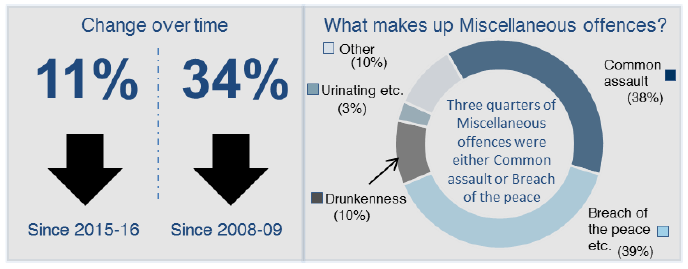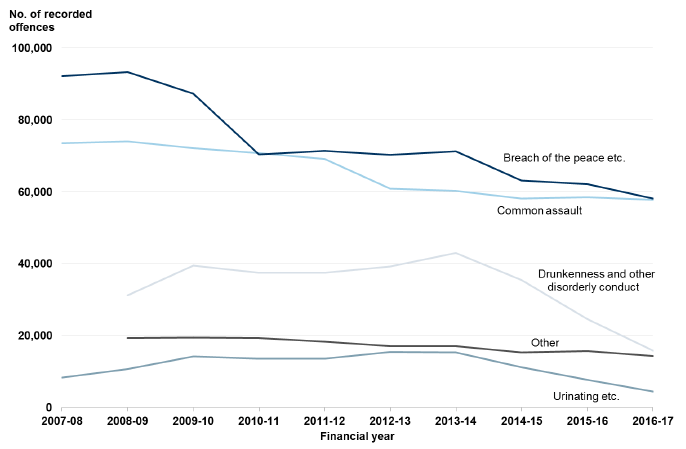Recorded crime in Scotland: 2016-2017
Statistics on crimes and offences recorded and cleared up by the police in Scotland, split by crime or offence group and by local authority.
This document is part of a collection
Group 6 – Miscellaneous Offences

Number of Miscellaneous offences recorded in 2016-17:
Miscellaneous offences account for just over half (52%) of all offences recorded in Scotland in 2016-17. Between 2015-16 and 2016-17, the number of Miscellaneous offences recorded by the police in Scotland decreased by 11%, from 168,896 to 150,793.
Due to a number of anomalies in the data for Miscellaneous offences, this group is only comparable from 2008-09 onwards. Further information on the comparability of Group 6 is available in the ' Data Considerations' section below, and in Annex 2.
The national rate of recorded Miscellaneous offences decreased from 314 per 10,000 population in 2015-16 to 279 offences per 10,000 population in 2016-17. This varied by local authority area, with the highest rate in Glasgow City (542 per 10,000 population) and the lowest rate in Na h-Eileanan Siar (113 per 10,000 population) ( Table 13).
Chart 17 shows the five categories within Miscellaneous offences over the last ten years, with Drunkenness and other disorderly conduct and Other miscellaneous offences from 2008-09. This chart gives an indication of the trend and scale of each category. Breach of the peace etc. and Common assault have consistently been the biggest contributors to Miscellaneous offences.
Chart 17: Miscellaneous offences in Scotland, 2007-08 to 2016-17

Breach of the peace etc.:
Breach of the peace etc. includes Breach of the peace, Threatening or abusive behaviour, Stalking, Offensive behaviour at football and Threatening communications. A further breakdown of Breach of the peace etc. into its component parts is available in Table A6.
Breach of the peace etc. is the largest category in Miscellaneous offences, accounting for more than a third (39%) in 2016-17. Over the ten year period from 2007-08 to 2016-17, this category has fallen by more than one third (37%), including a 6% decrease from 62,233 in 2015-16 to 58,235 in 2016-17.
All local authorities recorded a decrease in this category over the ten year period. Between 2015-16 and 2016-17, around two thirds (21) of local authorities showed a decrease.
Common assault:
Common assault also accounted for more than a third (38%) of Miscellaneous offences in 2016-17. Over the ten year period from 2007-08 to 2016-17, this category has fallen by around one fifth (21%), including a 1% decrease from 58,596 in 2015-16 to 57,861 in 2016-17.
All but two local authorities recorded a decrease in this category over the ten year period. Between 2015-16 and 2016-17, two thirds (21) of local authorities showed a decrease. For the distinction between Common assault and Serious assault please see Paragraph 7.13 within Annex 1.
Last year's bulletin presented the results of an analysis of police recorded common assault conducted by Scottish Government statisticians. Based on a review of 500 common assaults recorded by the police in 2014-15, it suggested that the gender of complainers was equally split between males and females (49% in each case). Perpetrators were more likely to be male or all male groups (74% of cases). It was also found that around half of common assault cases involve no or very little injury to the complainer. The remaining cases (again around half) involve some degree of injury to the complainer. More information can be found by accessing the 'Recorded Crime in Scotland, 2015-16' bulletin:
http://www.gov.scot/Topics/Statistics/Browse/Crime-Justice/PubRecordedCrime
Drunkenness and other disorderly conduct:
Drunkenness and other disorderly conduct includes offences such as Drunk and Incapable, Disorderly on licensed premises and Consumption of alcohol in designated places, byelaws prohibited. For further information on the classification of crimes and offences, please see Chapter 8.
Drunkenness and other disorderly conduct accounted for 10% of Miscellaneous offences in 2016-17. Despite some fluctuation, levels of this offence fell 50% between 2008-09 and 2016-17. This includes a 36% decrease from 24,639 in 2015-16 to 15,796 in 2016-17.
All but one local authority recorded a decrease in this category between 2008-09 and 2016-17. Between 2015-16 and 2016-17 all but five (27) local authorities showed a decrease.
It should be noted that the category Drunkenness and other disorderly conduct is not considered comparable for years prior to 2008-09. This is due to double counting of offences of Disorderly on licensed premises in legacy Tayside, and it has not been possible to correct these data prior to 2008-09. Further information on quality issues is available in the ' Data Considerations' section below, and in Annex 2.
Urinating etc.:
Urinating etc. accounted for 3% of Miscellaneous offences in 2016-17. This category generally increased for several years from 2007-08, peaking in 2012-13. Urinating etc. decreased by 41% from 7,700 in 2015-16 to 4,505 in 2016-17, the fourth consecutive decrease in these offences.
Three quarters (24) of local authority areas recorded a decrease in this category over the ten year period. Between 2015-16 and 2016-17 all but six (26) local authorities showed a decrease.
Other miscellaneous offences
The Other miscellaneous offences category includes a wide range of offences, including Racially aggravated harassment, Racially aggravated conduct, False/hoax calls, Offences invoving children and Offences involving animals/plants. For further information on the classification of crimes and offences, please see Chapter 8.
Other miscellaneous offences account for 10% of Miscellaneous offences in 2016-17. These offences decreased by 8% from 15,728 in 2015-16 to 14,396 in 2016-17.
All but five (27) local authorities recorded a decrease between 2008-09 and 2016-17. Between 2015-16 and 2016-17, 26 of the 32 local authorities showed a decrease.
It should be noted that the Other miscellaneous offences category is not considered comparable for years prior to 2008-09. Further information on quality issues is available in the ' Data Considerations' section below, and in Annex 2.
Data Considerations
As outlined in the overall section on police recorded offences – an extensive data quality exercise was carried out to assess the comparability of data extracted from the Scottish Operational and Management Information System ( ScOMIS) with data collected from legacy police forces and published in previous bulletins. This analysis identified that all data for Group 6, Miscellaneous Offences, are fully comparable from 2008-09 onwards. However, two offences are non-comparable prior to 2008-09: Disorderly on licensed premises (within the Drunkenness and other disorderly conduct category) and Control of Pollution (within the Other miscellaneous offences category). Therefore, comparisons for the Drunkenness and other disorderly conduct and Other miscellaneous offences categories in Group 6 should also only be made for 2008-09 onwards. The comparability of the remaining three categories in Group 6: Common assault; Breach of the peace etc. and Urinating etc. are not affected.
The Scottish Government produced a Technical Report in 2014 which detailed the quality assurance work it carried out in reaching this conclusion: http://www.gov.scot/Topics/Statistics/Browse/Crime-Justice/PubRecordedCrime
/TechnicalReport.
Data Validation
Scottish Government statisticians reviewed a random sample of 500 common assault crime records from 2014-15 to develop a better understanding of the nature of this type of offence. The quality of recording decisions for common assault by Police Scotland is very good, with 98% of common assaults classified correctly. Those records incorrectly classified as common assault were either a breach of the peace, a serious assault or insufficient detail was provided to dispel the notion a serious assault had occurred. The full findings and analysis from this sample can be found in last year's ' Recorded Crime in Scotland' publication.
HMICS Crime Audit 2016
It should be noted that in the HMICS audit report, violent crime includes Common assault. Please refer to the Group 1 - Non-sexual crimes of violence section. Further information on this audit, including definitions of terminology and tests used, can be found in Annex 2.
The previous HMICS Crime Audit, carried out in 2014, included a review of Hate Crime. Of the 504 hate crimes examined, 94% were counted and classified correctly. Five crimes were under-counted and six crimes were over-counted. There were no recurring themes in relation to counting errors for hate crime. However, the majority of classification errors related to the same technical issue around the classification of crimes between s.50(a) (1B) of the Criminal Law Consolidation (Scotland) Act 1005 and s.38 of the Criminal Justice and Licensing (Scotland) Act 2010.
The Test 1 compliance rate of 97% for hate crime was the best of the four crime categories audited in 2014. Test 1 failures tended to relate to a lack of information or update on the incident record to dispel criminality. In several incidents, the complainer became uncooperative but a crime should nonetheless have been recorded. In a few incidents, a crime had clearly taken place but no trace of a crime record could be found.
Data Comparisons
Racially aggravated harassment and conduct
The Other category in Miscellaneous offences contains offences of Racially aggravated harassment and Racially aggravated conduct, and Table A7 shows these offences for the last ten years. In 2016-17 there were 66 offences of Racially aggravated harassment and 1,927 offences of Racially aggravated conduct. While these include specific racially aggravated offences, they do not account for all criminal behaviour which may have had a racial motivation such as assault or vandalism.
The Racist Incidents Recorded by the Police in Scotland statistical bulletin series contains more detailed information on racist incidents such as victim/complainer and perpetrator characteristics, location of incident and the crimes recorded and cleared up as part of racist incidents.
We therefore recommend that users interested in racist incidents should refer directly to the Racist Incidents Recorded by the Police in Scotland bulletin series, available via the following link: http://www.gov.scot/Topics/Statistics/Browse/Crime-Justice/PubRacistIncidents.
The latest Racist Incidents Recorded by the Police in Scotland bulletin, containing data for 2013-14, was published in November 2015. This bulletin also outlined plans to scope out the possibility of replacing the racist incidents publication with a new and broader statistical product on police recorded Hate Crime. Scottish Government analysts are working with Police Scotland as they consider the Hate Crime data they hold on their existing systems, and we anticipate an update on this work before the end of the year.
Scottish Crime and Justice Survey ( SCJS)
In addition to information on police recorded crime, the SCJS provides a complementary outlook on crimes of violence through asking respondents about their experiences.
As previously noted, violent crime as defined by the SCJS is not directly comparable with non-sexual crimes of violence recorded by the Police. Common assaults, which make up the majority of SCJS violent crime, are included in the Miscellaneous offences police recorded crime group, and the Non-sexual crimes of violence crime group includes homicide.
A more detailed examination of comparisons between the SCJS and recorded crime is made within Chapter 5.
Key points from the Scottish Crime and Justice Survey:
As stated under the Non-sexual crimes of violence section, of the 688,000 crimes measured by the SCJS in 2014-15, 186,000 (27%) were violent crimes and it is estimated that 2.6% of adults in Scotland were a victim of violent crime in 2014-15.
In 2014-15, minor assaults made up the vast majority of SCJS violent crime (76%), followed by attempted assault (16%), serious assault (4%) and robbery (4%).
Further detail on the comparable crime set is available in Section 5.3. As outlined there and in the Annex of the 2014-15 SCJS, violent crime in the SCJS includes assault and robbery, crimes which are included in Group 1 (Non-sexual crimes of violence) and Group 6 (Miscellaneous offences) in police recorded crime figures.
As outlined in Section 5.3, recorded violent crime figures in the comparable category decreased by 24% between 2008-09 and 2014-15, while for the same period the SCJS estimates of violent crime decreased by 41% (a statistically significant change in the SCJS results).
Contact
Email: Jamie Macfarlane, jamie.macfarlane@gov.scot
Phone: 0300 244 4000 – Central Enquiry Unit
The Scottish Government
St Andrew's House
Regent Road
Edinburgh
EH1 3DG
There is a problem
Thanks for your feedback